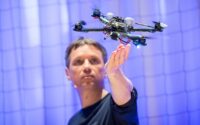Drone startups get ready for the new space race in Europe
The next frontier is U-space – open airspace for the use of drones. This increases the possibility of door-to-door delivery when the service provider is already there to handle the traffic
At the end of January, EU regulations governing airspace for drones, known as U-Spaces, came into force. The government is currently identifying regions and U-Space service providers with a target of full deployment by 2030. The change has huge implications for drone startups.
Hermann Øie Kolden, founder and chief executive officer of Norwegian startup Aviant, said: “There is now no doubt whether invisible home delivery will be allowed across Europe. It is required by law.” “So the door is open, but we have to show that we can get through it.”
Meanwhile, the question of how the rules work for most European countries remains open. “We are currently in a regulatory dilemma,” said Mattijs Damen, chief technology officer of Dutch startup Avy. certain part of the airspace.
At the end of 2020, EU regulations on civil drones will come into force, dividing operations into three risk-based categories, each of which requires a level of authorization and pilot license. different. This is followed by the U-Space regulation 2021, which defines a number of services and other measures to be performed in the airspace where drones regularly operate and in the airspace where the aircraft is deployed. driver and unmanned.
These services include a degree of digitization and automation, including registration and identification, flight planning and confirmation, day-to-day air traffic control interactions, and collision detection.
U-Space is not mandatory for companies that provide drone services in urban areas, but it does provide transparency about their operations. “You have to have rules and people have to follow them, and U-Space is important,” said Bobby Healy, founder and CEO of Manna. “It’s about doing it in a black and white way, where everything can be measured without human error.”
open door
All users of the airspace are subject to the same system. “Having a clear message that aerospace is now a mix of drones and general aviation has helped. It brought the general aviation community to the technical side and realizes that they are. I exist,” Healy said.
Founded in 2018, Manna uses drones to deliver hundreds of homes each week in Balbriggan, near Dublin. Healy is aiming to expand next year, which could coincide with U-Space’s rollout in Ireland. If the company wants to expand into other parts of Europe, U-space will also be a guide. “It was an open door for the market to accept U-Space services,” says Healy. “It shows that at the government level, they want to commercialize the airspace and maintain jobs and commerce.”
Branding for the U-space region is also key for Avian to expand beyond Norway. “It’s just a requirement to be able to use scale effectively,” says Colden.
Avian was founded in early 2020 by three NTNU students who met during their graduate program at MIT. The COVID-19 pandemic has prompted him to focus on medical logistics in his country, and he is exploring applications for drones. He developed and tested a vertical flying drone at MIT before returning to Norway to begin test service.
Avant is headquartered in Trondheim and has about 20 employees. Avant raised $2.3 million in its most recent seed round in November 2022. In 2021 and 2022, the company will ship medical supplies and samples 120 kilometers away and make 10 commercial contract. The company recently launched a home delivery service that operates within a 30 km radius of Trondheim.
Determine the domain of the space U
Although the marking of the U-Space area began on January 26, it will be some time before it becomes a reality. Even the most enthusiastic states have yet to translate these provisions into national law, and further progress will depend on which city decides to implement the proposal.
The initial focus will be on demonstration projects. Previous demonstration projects, such as the U-Space sandbox in the Port of Hamburg in 2021, were limited in size and had nowhere to go after construction. The situation is different for the AMIUS project, which will start in January 2022 and test the U space around Ingolstadt and Münching in Bavaria. If successful, this promises an easy transition to permanent U-space.
Drone companies looking to expand in Europe are looking at these demonstration projects in anticipation of the arrival of the territory established by U-Space, which is expected to launch in 2024 “We wanted to expand as quickly as possible in Europe, so right now we’re looking for the best small U-space projects that support commercial use to get started,” says Colden.
Participating in these early projects gives a company like Avian valuable experience and will likely be available when the official name is introduced. Of course, so did his opponent, but Colden didn’t care. “The rule is very clear, once the U-Space area is up and running, it will be open to everyone. In the immediate future, I am very pleased with the progress of ROOT.”
The more companies involved, the faster open-ended questions about common standards were clarified, benefiting the industry as a whole.
In Avi, it’s a bit more complicated. Once the U-Space environment is released, it will become clearer what rules must be followed and which third-party vendors must integrate with the drone platform, especially Service Providers. U-Space (USSP). What is crucial, however, is the deployment of the U-Space zone.
“If there are 600 different sub-airspace components, that will be difficult and troublesome for us because we will have to integrate many different USSPs,” Damen said. “But if it is done on a large scale, with a large area dedicated to a single U-space provider, and with clear integration requirements, then it can certainly be beneficial. .”
At the same time, early entry poses risks for drone companies, as technical efforts to integrate USSP and drone platforms are not small. Companies like Avy want to know that the resources they invest are worth it.
“We don’t want to turn the integration of many different USSPs into a one-off technology project,” says Damen. “We wanted to create a flexible API that could be used with different USSPs so that our customers could operate in the airspace assigned to different USSPs.”
This ambiguity makes participation in U-Space demonstration or experimental projects less attractive, as participating service providers may not be selected to deploy U-spaces. Space. “So we risk working hard to temporarily integrate into the USSP if we don’t know what will happen in the future.”
While U-Space is suitable for civil drones in Europe, it will not solve all of the industry’s problems. Most important to Healy is the lack of funding to support the growth that is currently allowed under the regulation. “In this industry, not 50 or tens of millions of dollars but hundreds of millions of dollars, unfortunately, there is no such level of venture capital in Europe,” he said.
A natural place to look for such investments is the United States, but the relationship there is tied to the domestic market. “The US has been ahead of Europe in terms of large-scale drone deployments for many years,” Healy said. “This is probably the biggest factor holding back industry growth in Europe: a lack of understanding of the direction the industry is going in the US.”
Meanwhile, there are questions about what will happen between Avian U-Space sites, which should only be deployed in areas with high drone traffic. “If there’s no regulation of airspace, what do you do with drones and drones? It’s uncontrolled airspace, by definition anyone can fly there.” , Corden said.
That’s also a concern for Wingcopter, a German startup founded in 2017 with planes that carry out missions over 100 kilometers, such as connecting rural medical facilities with central laboratories. “It can go beyond U-shaped space, so we will continue to develop technology to make safe, invisible flights into space,” said Ansgar Kadura, a partner at the company. U-shaped”. Founder and CEO. “But in this case, U-space doesn’t match the capabilities of the Wingcopter drone.”
Healy wants to see U-Space expand as much as possible, not just in areas with the highest concentrations of drones. “U-space is a simple and elegant answer to a very complicated contract between these parties. So I would appreciate it if all of our flights were in U-space, not only when tactically necessary.”



